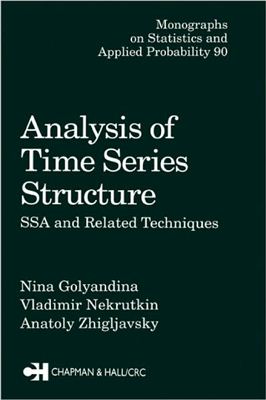Chapman & Hall. 2001. Pages: 320
Singular spectrum analysis (SSA) has proven very successful. It has already become a standard tool in climatic and meteorological time series analysis and well known in nonlinear physics and signal processing. However, despite the promise it holds for time series applications in other disciplines, SSA is not widely known among statisticians and econometrists, and although the basic SSA algorithm looks simple, understanding what it does and where its pitfalls lay is by no means simple.Analysis ofTime Series Structure: SSA and Related Techniques provides a careful, lucid description of its general theory and methodology. Part I introduces the basic concepts, and sets forth the main findings and results, then presents a detailed treatment of the methodology. After introducing the basic SSA algorithm, the authors explore forecasting and apply SSA ideas to change-point detection algorithms. Part II is devoted to the theory of SSA. Here the authors formulate and prove the statements of Part I. They address thesingular value decomposition (SVD) of real matrices, time series of finite rank, and SVD of trajectory matrices.Based on the authors' original work and filled with applications illustrated with real data sets, this book offers an outstanding opportunity to obtain a working knowledge of why, when, and how SSA works. It builds a strong foundation for successfully using the technique in applications ranging from mathematics and nonlinear physics to economics, biology, oceanology, social science, engineering, financial econometrics, and market research.
Singular spectrum analysis (SSA) has proven very successful. It has already become a standard tool in climatic and meteorological time series analysis and well known in nonlinear physics and signal processing. However, despite the promise it holds for time series applications in other disciplines, SSA is not widely known among statisticians and econometrists, and although the basic SSA algorithm looks simple, understanding what it does and where its pitfalls lay is by no means simple.Analysis ofTime Series Structure: SSA and Related Techniques provides a careful, lucid description of its general theory and methodology. Part I introduces the basic concepts, and sets forth the main findings and results, then presents a detailed treatment of the methodology. After introducing the basic SSA algorithm, the authors explore forecasting and apply SSA ideas to change-point detection algorithms. Part II is devoted to the theory of SSA. Here the authors formulate and prove the statements of Part I. They address thesingular value decomposition (SVD) of real matrices, time series of finite rank, and SVD of trajectory matrices.Based on the authors' original work and filled with applications illustrated with real data sets, this book offers an outstanding opportunity to obtain a working knowledge of why, when, and how SSA works. It builds a strong foundation for successfully using the technique in applications ranging from mathematics and nonlinear physics to economics, biology, oceanology, social science, engineering, financial econometrics, and market research.

